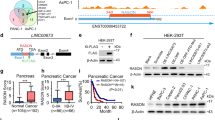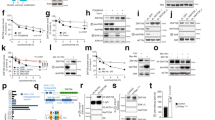Abstract
Glycogen synthase kinase-3 beta (GSK-3β) is overexpressed in a number of human malignancies and has been shown to contribute to tumor cell proliferation and survival. Although regulation of GSK-3β activity has been extensively studied, the mechanisms governing GSK-3β gene expression are still unknown. Using pancreatic cancer as a model, we find that constitutively active Ras signaling increases GSK-3β gene expression via the canonical mitogen-activated protein kinase signaling pathway. Analysis of the mechanism revealed that K-Ras regulates the expression of this kinase through two highly conserved E-twenty six (ETS) binding elements within the proximal region. Furthermore, we demonstrate that mutant K-Ras enhances ETS2 loading onto the promoter, and ETS requires its transcriptional activity to increase GSK-3β gene transcription in pancreatic cancer cells. Lastly, we show that ETS2 cooperates with p300 histone acetyltransferase to remodel chromatin and promote GSK-3β expression. Taken together, these results provide a general mechanism for increased expression of GSK-3β in pancreatic cancer and perhaps other cancers, where Ras signaling is deregulated.
This is a preview of subscription content, access via your institution
Access options
Subscribe to this journal
Receive 50 print issues and online access
$259.00 per year
only $5.18 per issue
Buy this article
- Purchase on Springer Link
- Instant access to full article PDF
Prices may be subject to local taxes which are calculated during checkout







Similar content being viewed by others
References
Arvand A, Denny CT . (2001). Biology of EWS/ETS fusions in Ewing′s family tumors. Oncogene 20: 5747–5754.
Bilim V, Ougolkov A, Yuuki K, Naito S, Kawazoe H, Muto A et al. (2009). Glycogen synthase kinase-3: a new therapeutic target in renal cell carcinoma. Br J Cancer 101: 2005–2014.
Billadeau DD . (2007). Primers on molecular pathways. The glycogen synthase kinase-3beta. Pancreatology 7: 398–402.
Cao Q, Lu X, Feng YJ . (2006). Glycogen synthase kinase-3beta positively regulates the proliferation of human ovarian cancer cells. Cell Res 16: 671–677.
Clark JP, Cooper CS . (2009). ETS gene fusions in prostate cancer. Nat Rev Urol 6: 429–439.
Daujat S, Bauer M, Shah V, Turner B, Berger S, Kouzarides T . (2002). Crosstalk between CARM1 methylation and CBP acetylation on histone H3. Curr Biol 12: 2090–2097.
Deramaudt T, Rustgi AK . (2005). Mutant KRAS in the initiation of pancreatic cancer. Biochim Biophys Acta 1756: 97–101.
Downward J . (2003). Targeting RAS signalling pathways in cancer therapy. Nat Rev Cancer 3: 11–22.
Fauquette V, Perrais M, Cerulis S, Jonckheere N, Ducourouble MP, Aubert JP et al. (2005). The antagonistic regulation of human MUC4 and ErbB-2 genes by the Ets protein PEA3 in pancreatic cancer cells: implications for the proliferation/differentiation balance in the cells. Biochem J 386: 35–45.
Foulds CE, Nelson ML, Blaszczak AG, Graves BJ . (2004). Ras/mitogen-activated protein kinase signaling activates Ets-1 and Ets-2 by CBP/p300 recruitment. Mol Cell Biol 24: 10954–10964.
Gutierrez-Hartmann A, Duval DL, Bradford AP . (2007). ETS transcription factors in endocrine systems. Trends Endocrinol Metab 18: 150–158.
Hezel AF, Kimmelman AC, Stanger BZ, Bardeesy N, Depinho RA . (2006). Genetics and biology of pancreatic ductal adenocarcinoma. Genes Dev 20: 1218–1249.
Hollenhorst PC, Jones DA, Graves BJ . (2004). Expression profiles frame the promoter specificity dilemma of the ETS family of transcription factors. Nucleic Acids Res 32: 5693–5702.
Hollenhorst PC, Shah AA, Hopkins C, Graves BJ . (2007). Genome-wide analyses reveal properties of redundant and specific promoter occupancy within the ETS gene family. Genes Dev 21: 1882–1894.
Ito H, Duxbury M, Benoit E, Clancy TE, Zinner MJ, Ashley SW et al. (2004). Prostaglandin E2 enhances pancreatic cancer invasiveness through an Ets-1-dependent induction of matrix metalloproteinase-2. Cancer Res 64: 7439–7446.
Ito T, Nakayama T, Ito M, Naito S, Kanematsu T, Sekine I . (1998). Expression of the ets-1 proto-oncogene in human pancreatic carcinoma. Mod Pathol 11: 209–215.
Ito Y, Miyoshi E, Takeda T, Sakon M, Ihara S, Tsujimoto M et al. (2002). Ets-2 overexpression contributes to progression of pancreatic adenocarcinoma. Oncol Rep 9: 853–857.
Janknecht R . (2005). EWS-ETS oncoproteins: the linchpins of Ewing tumors. Gene 363: 1–14.
Jayaraman G, Srinivas R, Duggan C, Ferreira E, Swaminathan S, Somasundaram K et al. (1999). p300/cAMP-responsive element-binding protein interactions with ets-1 and ets-2 in the transcriptional activation of the human stromelysin promoter. J Biol Chem 274: 17342–17352.
Jedlicka P, Gutierrez-Hartmann A . (2008). Ets transcription factors in intestinal morphogenesis, homeostasis and disease. Histol Histopathol 23: 1417–1424.
Jope RS, Johnson GV . (2004). The glamour and gloom of glycogen synthase kinase-3. Trends Biochem Sci 29: 95–102.
Kim EK, Choi EJ . (2010). Pathological roles of MAPK signaling pathways in human diseases. Biochim Biophys Acta 1802: 396–405.
Kobberup S, Nyeng P, Juhl K, Hutton J, Jensen J . (2007). ETS-family genes in pancreatic development. Dev Dyn 236: 3100–3110.
Koenig A, Linhart T, Schlengemann K, Reutlinger K, Wegele J, Adler G et al. (2010). NFAT-induced histone acetylation relay switch promotes c-Myc-dependent growth in pancreatic cancer cells. Gastroenterology 138: 1189–1199.
Kotliarova S, Pastorino S, Kovell LC, Kotliarov Y, Song H, Zhang W et al. (2008). Glycogen synthase kinase-3 inhibition induces glioma cell death through c-MYC, nuclear factor-kappaB, and glucose regulation. Cancer Res 68: 6643–6651.
Lau KF, Miller CC, Anderton BH, Shaw PC . (1999a). Molecular cloning and characterization of the human glycogen synthase kinase-3beta promoter. Genomics 60: 121–128.
Lau KF, Miller CC, Anderton BH, Shaw PC . (1999b). Expression analysis of glycogen synthase kinase-3 in human tissues. J Pept Res 54: 85–91.
Lefter LP, Dima S, Sunamura M, Furukawa T, Sato Y, Abe M et al. (2009). Transcriptional silencing of ETS-1 efficiently suppresses angiogenesis of pancreatic cancer. Cancer Gene Ther 16: 137–148.
Li QJ, Yang SH, Maeda Y, Sladek FM, Sharrocks AD, Martins-Green M . (2003a). MAP kinase phosphorylation-dependent activation of Elk-1 leads to activation of the co-activator p300. EMBO J 22: 281–291.
Li R, Erdamar S, Dai H, Sayeeduddin M, Frolov A, Wheeler TM et al. (2009b). Cytoplasmic accumulation of glycogen synthase kinase-3beta is associated with aggressive clinicopathological features in human prostate cancer. Anticancer Res 29: 2077–2081.
Li YY, Wu Y, Tsuneyama K, Baba T, Mukaida N . (2009). Essential contribution of Ets-1 to constitutive Pim-3 expression in human pancreatic cancer cells. Cancer Sci 100: 396–404.
Luo J . (2009). Glycogen synthase kinase 3beta (GSK3beta) in tumorigenesis and cancer chemotherapy. Cancer Lett 273: 194–200.
Maitra A, Kern SE, Hruban RH . (2006). Molecular pathogenesis of pancreatic cancer. Best Pract Res Clin Gastroenterol 20: 211–226.
Narod SA, Seth A, Nam R . (2008). Fusion in the ETS gene family and prostate cancer. Br J Cancer 99: 847–851.
Nelson ML, Kang HS, Lee GM, Blaszczak AG, Lau DK, McIntosh LP et al. (2010). Ras signaling requires dynamic properties of Ets1 for phosphorylation-enhanced binding to coactivator CBP. Proc Natl Acad Sci USA 107: 10026–10031.
Ougolkov AV, Fernandez-Zapico ME, Bilim VN, Smyrk TC, Chari ST, Billadeau DD . (2006). Aberrant nuclear accumulation of glycogen synthase kinase-3beta in human pancreatic cancer: association with kinase activity and tumor dedifferentiation. Clin Cancer Res 12: 5074–5081.
Ougolkov AV, Fernandez-Zapico ME, Savoy DN, Urrutia RA, Billadeau DD . (2005). Glycogen synthase kinase-3beta participates in nuclear factor kappaB-mediated gene transcription and cell survival in pancreatic cancer cells. Cancer Res 65: 2076–2081.
Polakis P . (2000). Wnt signaling and cancer. Genes Dev 14: 1837–1851.
Rowley M, Ohashi A, Mondal G, Mills L, Yang L, Zhang L et al. (2011). Inactivation of Brca2 promotes Trp53-associated but inhibits KrasG12D-dependent pancreatic cancer development in mice. Gastroenterology (e-pub ahead of print 14 March 2011).
Rubinfeld B, Albert I, Porfiri E, Fiol C, Munemitsu S, Polakis P . (1996). Binding of GSK3beta to the APC-beta-catenin complex and regulation of complex assembly. Science 272: 1023–1026.
Shakoori A, Ougolkov A, Yu ZW, Zhang B, Modarressi MH, Billadeau DD et al. (2005). Deregulated GSK3beta activity in colorectal cancer: its association with tumor cell survival and proliferation. Biochem Biophys Res Commun 334: 1365–1373.
Tootle TL, Rebay I . (2005). Post-translational modifications influence transcription factor activity: a view from the ETS superfamily. Bioessays 27: 285–298.
Wai PY, Mi Z, Gao C, Guo H, Marroquin C, Kuo PC . (2006). Ets-1 and runx2 regulate transcription of a metastatic gene, osteopontin, in murine colorectal cancer cells. J Biol Chem 281: 18973–18982.
Wasylyk B, Hagman J, Gutierrez-Hartmann A . (1998). Ets transcription factors: nuclear effectors of the Ras-MAP-kinase signaling pathway. Trends Biochem Sci 23: 213–216.
Yang B, Hauser C, Henkel G, Colman M, Van Beveren C, Stacey K et al. (1996). Ras-mediated phosphorylation of a conserved threonine residue enhances the transactivation activities of c-Ets1 and c-Ets2. Mol Cell Biol 16: 538–547.
Yang C, Shapiro LH, Rivera M, Kumar A, Brindle PK . (1998). A role for CREB binding protein and p300 transcriptional coactivators in Ets-1 transactivation functions. Mol Cell Biol 18: 2218–2229.
Zhang JS, Moncrieffe MC, Kaczynski J, Ellenrieder V, Prendergast FG, Urrutia R . (2001). A conserved alpha-helical motif mediates the interaction of Sp1-like transcriptional repressors with the corepressor mSin3A. Mol Cell Biol 21: 5041–5049.
Acknowledgements
Mayo Clinic Pancreatic Cancer SPORE grant CA102701 (DDB and MEF-Z). DDB is a Leukemia and Lymphoma Scholar. AK is supported by a Mildred-Scheel fellowship of German Cancer Society.
Author information
Authors and Affiliations
Corresponding authors
Ethics declarations
Competing interests
The authors declare no conflict of interest.
Additional information
Supplementary Information accompanies the paper on the Oncogene website
Rights and permissions
About this article
Cite this article
Zhang, JS., Koenig, A., Harrison, A. et al. Mutant K-Ras increases GSK-3β gene expression via an ETS-p300 transcriptional complex in pancreatic cancer. Oncogene 30, 3705–3715 (2011). https://doi.org/10.1038/onc.2011.90
Received:
Revised:
Accepted:
Published:
Issue Date:
DOI: https://doi.org/10.1038/onc.2011.90
Keywords
This article is cited by
-
A novel lncRNA LNC_000052 leads to the dysfunction of osteoporotic BMSCs via the miR-96-5p–PIK3R1 axis
Cell Death & Disease (2020)
-
A conjugated mTOR/MEK bifunctional inhibitor as potential polypharmacological anticancer agent: the prototype compound discovery
Medicinal Chemistry Research (2020)
-
Phosphorylation Regulates CAP1 (Cyclase-Associated Protein 1) Functions in the Motility and Invasion of Pancreatic Cancer Cells
Scientific Reports (2019)
-
MYC in pancreatic cancer: novel mechanistic insights and their translation into therapeutic strategies
Oncogene (2016)
-
Ras Activity Oscillates in the Mouse Suprachiasmatic Nucleus and Modulates Circadian Clock Dynamics
Molecular Neurobiology (2016)



